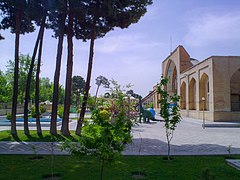
Islamic architecture comprises the architectural styles of buildings associated with Islam. It encompasses both secular and religious styles from the early history of Islam to the present day. The Islamic world encompasses a wide geographic area historically ranging from western Africa and Europe to eastern Asia. Certain commonalities are shared by Islamic architectural styles across all these regions, but over time different regions developed their own styles according to local materials and techniques, local dynasties and patrons, different regional centers of artistic production, and sometimes different religious affiliations.
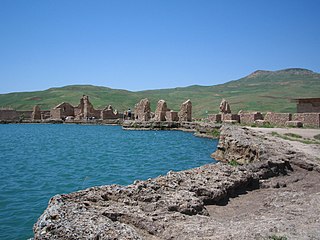
Takht-e Soleymān or Adur Gushnasp, is an archaeological site in West Azerbaijan, Iran dating back to Sasanian Empire. It lies midway between Urmia and Hamadan, very near the present-day town of Takab, and 400 km (250 mi) west of Tehran.

Iranian architecture or Persian architecture is the architecture of Iran and parts of the rest of West Asia, the Caucasus and Central Asia. Its history dates back to at least 5,000 BC with characteristic examples distributed over a vast area from Turkey and Iraq to Uzbekistan and Tajikistan, and from the Caucasus to Zanzibar. Persian buildings vary greatly in scale and function, from vernacular architecture to monumental complexes. In addition to historic gates, palaces, and mosques, the rapid growth of cities such as the capital Tehran has brought about a wave of demolition and new construction.

Chehel Sotoun is a Persian pavilion in the middle of a park at the far end of a long pool, in Isfahan, Iran, built by Shah Abbas II to be used for his entertainment and receptions. In this palace, Shah Abbas II and his successors would receive dignitaries and ambassadors, either on the terrace or in one of the stately reception halls.

Ali Qapu Palace or the Grand Ali Qapu is an imperial palace in Isfahan, Iran. It is located on the western side of the Naqsh-e Jahan Square, opposite to Sheikh Lotfollah Mosque, and had been originally designed as a vast portal entrance to the grand palace which stretched from the Naqsh-e Jahan Square to the Chahar Baq Boulevard. The palace served as the official residence of Persian Emperors of the Safavid dynasty. UNESCO inscribed the Palace and the Square as a World Heritage Site due to its cultural and historical importance. The palace is forty-eight meters high and there are six floors, each accessible by a difficult spiral staircase. In the sixth floor, Music Hall, deep circular niches are found in the walls, having not only aesthetic value, but also acoustic. Ali Qapu is regarded as the best example of Safavid architecture and a symbol of Iran's Islamic heritage.

Stucco decoration in Islamic architecture refers to carved or molded stucco and plaster. The terms "stucco" and "plaster" are used almost interchangeably in this context to denote most types of stucco or plaster decoration with slightly varying compositions. This decoration was mainly used to cover walls and surfaces and the main motifs were those predominant in Islamic art: geometric, arabesque, and calligraphic, as well as three-dimensional muqarnas. Plaster of gypsum composition was extremely important in Islamic architectural decoration as the relatively dry climate throughout much of the Islamic world made it easy to use this cheap and versatile material in a variety of spaces.

The Jāmeh Mosque of Isfahān or Jāme' Mosque of Isfahān, also known as the Atiq Mosque and the Friday Mosque of Isfahān, is a historic congregational mosque (Jāmeh) of Isfahan, Iran. The mosque is the result of continual construction, reconstruction, additions and renovations on the site from around 771 to the end of the 20th century. The Grand Bazaar of Isfahan can be found towards the southwest wing of the mosque. It has been a UNESCO World Heritage Site since 2012. It is one of the largest and most important monuments of Islamic architecture in Iran.

The Madrasa Bou Inania is a madrasa in Fes, Morocco, built in 1350–55 CE by Abu Inan Faris. It is the only madrasa in Morocco which also functioned as a congregational mosque. It is widely acknowledged as a high point of Marinid architecture and of historic Moroccan architecture generally.

The Al-Attarine Madrasa or Medersa al-Attarine is a madrasa in Fes, Morocco, near the Al-Qarawiyyin Mosque. It was built by the Marinid sultan Uthman II Abu Said in 1323-5. The madrasa takes its name from the Souk al-Attarine, the spice and perfume market. It is considered one of the highest achievements of Marinid architecture due to its rich and harmonious decoration and its efficient use of limited space.

Muqarnas, also known in Iberian architecture as Mocárabe, is a form of ornamented vaulting in Islamic architecture. It is the archetypal form of Islamic architecture, integral to the vernacular of Islamic buildings. It was most likely first developed in eleventh-century Iraq, though the earliest preserved examples are also found outside this region.
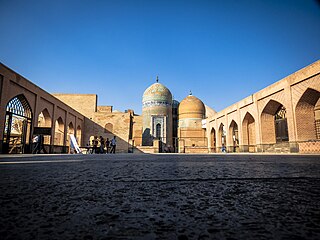
Sheikh Safi al-Din Khānegāh and Shrine Ensemble is the tomb of Sheikh Safi-ad-din Ardabili located in Ardabil, Iran. In 2010, it was registered on the UNESCO World Heritage List.

Seljuk architecture comprises the building traditions that developed under the Seljuk dynasty, when it ruled most of the Middle East and Anatolia during the 11th to 13th centuries. The Great Seljuk Empire contributed significantly to the architecture of Iran and surrounding regions, introducing innovations such as the symmetrical four-iwan layout and the first widespread creation of state-sponsored madrasas. Their buildings were generally constructed in brick, with decoration created using brickwork, tiles, and carved stucco.

Abbasid architecture developed in the Abbasid Caliphate between 750 and 1227, primarily in its heartland of Mesopotamia . The great changes of the Abbasid era can be characterized as at the same time political, geo-political and cultural. The Abbasid period starts with the destruction of the Umayyad ruling family and its replacement by the Abbasids, and the position of power is shifted to the Mesopotamian area. As a result there was a corresponding displacement of the influence of classical and Byzantine artistic and cultural standards in favor of local Mesopotamian models as well as Persian. The Abbasids evolved distinctive styles of their own, particularly in decoration. This occurred mainly during the period corresponding with their power and prosperity between 750 and 932.

Imamzadeh Ahmad is an imamzadeh in Isfahan, Iran. The Imamzadeh comprises a tomb, to the north and west of which are two iwans; the tomb faces a vast yard where several famous people, like Amir Kabir's daughter and Naser al-Din Shah's sister and wife, are buried. The emamzadeh himself was likely the Sultan Ali's son, who has been buried in Mashhad-e Ardehal.
Saint Mary Church of New Julfa is a historical Armenian church in Isfahan, Iran, completed in 1613.
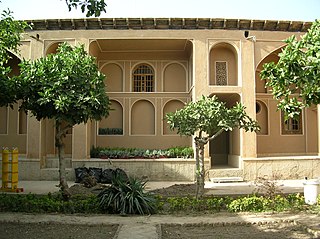
The Qazvinis' House is a historical house in Isfahan, Iran. It belongs to the age of Naser al-Din Shah Qajar.
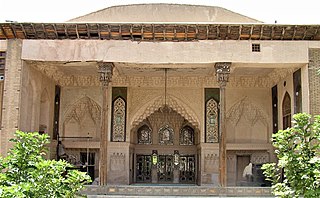
The Sheykh ol-Eslam's house is a house in Isfahan, Iran. Built during the Qajar era, the house is built on the northern and southern sides of the large yard. The reason for this unusual plan, which is completely different from other historical houses in Isfahan, is that the yard had been built originally as a Tekyeh for religious ceremonies. The main parts of the structure are on the southern side of the yard behind a veranda. Stucco, decorations with cut mirrors and muqarnas have made this part of the house much more prominent. There is a big reception hall with two rooms behind the southern veranda, and there is a Howz and two small flower garden opposite the northern veranda. In the southwestern part of the house, there is a small courtyard, which is connected to the main courtyard by a narrow corridor.

The Museum of Contemporary Art is a contemporary art museum in Isfahan, Iran, located next to the Museum of Natural History. The museum is housed in the Chaharbagh Palace, originally built in 17th century under Safavid rule.

The Jameh Mosque of Natanz is located in the city of Natanz, Isfahan province. It dates back to the Mongol Ilkhanid period and was first constructed during the reign of the Mongol ruler Öljaitü. The structure is a complex comprising a mosque, a khanqah and the tomb of Abdul Samad al-Isfahani, a prominent Sufi ascetic.

The Bab Doukkala Mosque or Mosque of Bab Doukkala is a major neighbourhood mosque in Marrakesh, Morocco, dating from the 16th century. It is named after the nearby city gate, Bab Doukkala, in the western city walls. It is also known as the al-Hurra Mosque.


